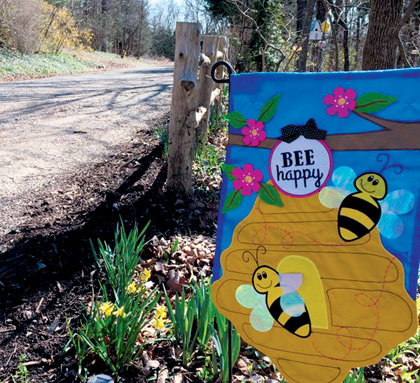Swarm Season

The countdown has started. Reports are trickling in that drone brood, or male baby bees not yet born, have been spotted. It’s just a matter of a few more warm days before they will be hatching and all of a sudden, bee swarm season will be here.
Swarm season is when bee colonies decide to split, nature’s way of ensuring a bee colony propagates itself. The old queen bee takes one third of the bees and takes off, scout bees fanning off to locate a new home over a five-day period. Left behind is a newly-hatched daughter and the remaining bees, all set to start a brand new bee colony.
I love catching swarms, from getting the call to settling them into a new home and then waiting to see if they actually settle in. To think of “swarming” as something scary and frightening takes me aback every time I talk to someone who throws that term around because frightening and swarming do not belong in the same sentence.
When a bee colony swarms, they fill up with honey and take off in a very carefully orchestrated and orderly fashion, it is quite amazing to listen to and watch. Because they have left their home, they have nothing to defend except their queen so they bunch up around her, literally hanging out waiting for the scouts to come back with information about new real estate options. If one is lucky, a beekeeper can entice a colony into a new home with ample space, frames already with places for the queen to lay, and a whiff of delicious ready to eat honey.
Bee swarms are at their most docile, when they first swarm and are full of honey. Towards the end of their 3-5 day life in a swarm, if they still haven’t found a new home, they can be hungry and cranky so if you see a swarm, please don’t swat at it or spray it with water. Note where it is located, leave it alone and visit rollabeeclub.com for a list of beekeepers in mid-Missouri who are interested in being called to come out to catch a swarm.
Last year I had a couple of swarm calls where the person calling wanted to charge me to get the bees. Interesting business model except that there is no guarantee once one gets a swarm into a hive that the swarm will stay, there’s a high percentage that don’t so not a business idea I would recommend pursuing.
My bee buddy, David, and I have been getting ready. We are getting our cars packed, hives set up, checking supplies, bee suits cleaned. Well, David finally washed HIS suit. It’s been a longstanding joke that his suit was standing because he had not cleaned it for a very long time.
Once a call does come in, one doesn’t have a lot of time to dilly-dally around. It’s on with the suit and off we go to try to locate the bees and hopefully get them quickly settled in.
Charlotte Ekker Wiggins is a beekeeper, gardener and sometimes cook. Published by El Dorado Springs Sun once in print and online with author’s permission. Copyright 2017, all rights reserved. This column may not be reprinted, republished or otherwise distributed without author’s permission. Contact Charlotte at gardeningcharlotte at gmail dot com.
 WHEN THE FLAG DROPS – My new garden flag marks the spot where my bee buddy David parks waiting for me to grab my bee suit on our way to a swarm call.
WHEN THE FLAG DROPS – My new garden flag marks the spot where my bee buddy David parks waiting for me to grab my bee suit on our way to a swarm call.

PORT IN A STORM – This nucleus box picked up a swarm in a parking lot last year right before a rain storm would have drowned the little colony. Once the queen bee was in the box, the rest of the bees followed her inside. (Photos by Charlotte Ekker Wiggins).



Facebook Comments